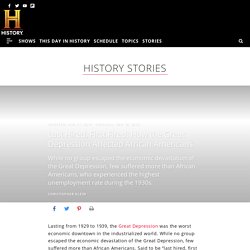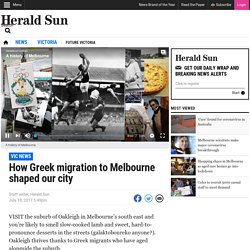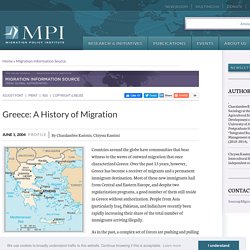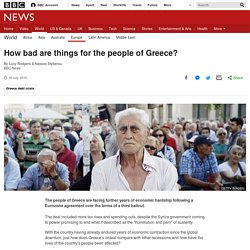

Great Depression Timeline: 1929 - 1941. June 17: Hoover signed the Smoot-Hawley Tariff Act, which raised taxes on 900 imports.

It originally was supposed to help farmers but ended up imposing tariffs on hundreds of other products. Other countries retaliated, setting off a trade war. As a result, international trade began to collapse. A drought hit 23 states from the Mississippi River to the mid-Atlantic region. It was the first of what was later called the Dust Bowl drought, the worst in 300 years. July 21: Hoover created the Department of Veterans Affairs. November 7: The Bank of Tennessee failed. December 11: The Bank of the United States failed. African Americans - African American life during the Great Depression and the New Deal.
The Great Depression of the 1930s worsened the already bleak economic situation of African Americans.

They were the first to be laid off from their jobs, and they suffered from an unemployment rate two to three times that of whites. In early public assistance programs African Americans often received substantially less aid than whites, and some charitable organizations even excluded blacks from their soup kitchens. This intensified economic plight sparked major political developments among African Americans. Beginning in 1929, the St. Louis Urban League launched a national “jobs for Negroes” movement by boycotting chain stores that had mostly black customers but hired only white employees. What was jamaica like in 1930 - Recherche Google.
The Fascist hero who changed the course of History. “Hence, we will not say that Greeks fight like heroes, but that heroes fight like Greeks.”

(Winston Churchill – 1941) Ioannis Metaxas has been described by many as a fascist, a nationalist, a dictator, a patriot, a leader, and a hero. However, no matter the term one may use to describe him, Greek General and Prime Minister Ioannis Metaxas is, and will undoubtedly continue to be remembered as one of the greatest leaders in modern history. Last Hired, First Fired: How the Great Depression Affected African Americans. Lasting from 1929 to 1939, the Great Depression was the worst economic downtown in the industrialized world.

While no group escaped the economic devastation of the Great Depression, few suffered more than African Americans. Said to be “last hired, first fired,” African Americans were the first to see hours and jobs cut, and they experienced the highest unemployment rate during the 1930s. Since they were already relegated to lower-paying professions, African Americans had less of a financial cushion to fall back on when the economy collapsed.
The Great Depression impacted African Americans for decades to come. Melbourne’s Greek community: How migrants from Greece have transformed our city. VISIT the suburb of Oakleigh in Melbourne’s south east and you’re likely to smell slow-cooked lamb and sweet, hard-to-pronounce desserts in the streets (galaktoboureko anyone?).

Oakleigh thrives thanks to Greek migrants who have aged alongside the suburb. But it’s not just Oakleigh — Greek migrants shaped Melbourne into Australia’s cultural hub, University of Melbourne Australian cultural historian Professor Joy Damousi said. “By any measure, the Greek community has fundamentally transformed Melbourne’s culture through its immediate difference like food and other cultural combinations,” Professor Damousi said. Migration experience of Greece and the impact of the economic crisis on its migrant and native populations. We use cookies to enhance your experience on our website.By continuing to use our website, you are agreeing to our use of cookies.

You can change your cookie settings at any time. <a href=" Find out more</a> Skip to Main Content Search Close Advanced Search Search Menu Article Navigation Volume 28 Issue suppl_5 December 2018 Article Contents. Greece’s population shrinking due to crisis. Greece: A History of Migration. Countries around the globe have communities that bear witness to the waves of outward migration that once characterized Greece.

Over the past 15 years, however, Greece has become a receiver of migrants and a permanent immigrant destination. Most of these new immigrants hail from Central and Eastern Europe, and despite two regularization programs, a good number of them still reside in Greece without authorization. People from Asia (particularly Iraq, Pakistan, and India) have recently been rapidly increasing their share of the total number of immigrants arriving illegally.
As in the past, a complex set of forces are pushing and pulling migration to and from Greece. Today, the government is poised to implement an integration action plan aimed at harnessing these forces to the country's advantage. Greek History: Waves of Emigration More than one million Greeks migrated in this second wave, which mainly fell between 1950 and 1974. - The Washington Post. How bad are things for the people of Greece? Image copyright Getty Images.

Greece: A History of Migration. - The Washington Post. Origins.museumsvictoria.com. Immigration History from Greece to Victoria Greeks have been establishing new lives in Victoria ever since the gold rush of the 1850s.

Many Greeks were amongst the sailors who left their English ships in Australian waters when they heard the discovery of gold. Most intended to return home rich men, so few women came to join them. By 1871, there were still only 19 Greece-born women in Victoria, and 127 men. After the gold declined, those who stayed found work in restaurants, cafes and shops. The community commenced to consolidate through chain migration - relatives and townspeople joining Greek settlers already here.